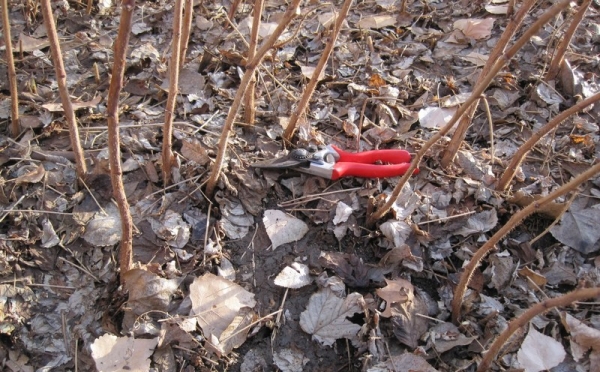Most people are convinced that raspberry unpretentious plant, but any gardener knows perfectly well how a lack of attention to her “majesty” is reflected in the harvest.
Anyone who wants to savor the sweet berries, must arm themselves with the necessary knowledge and desire to provide the necessary care for raspberries.
Table of contents
Good care for raspberries in August and September: pruning, pruning, fertilizer and more
List of necessary for raspberry action is as follows:
- fertilizer;
- pest removal;
- trimming and trimming;
- control over the growth of bushes;
- mulching;
- garter and bending down.
It is difficult to say which care is prioritized, all of the above is important.
Fertilizer needed, so that the plant root gets the necessary minerals and nutrients, without which it can not fully develop. Thanks to feeding, the raspberry stalks will be able to thicken and fill with fructose, helping to survive the cold weather.
Removal of harmful insects, fungi and other detractors are done by pruning, because most of them settle in on the tops of the plants.
If you do not get rid of pests, the plant may die or become weak, infertile. Another spraying is carried out in order to surely destroy the enemies.
Pruning need not only to remove pests, but also for harvesting old raspberry shoots. Old-timers will slow down the development of the plant, will not give the desired yield, because the ability to give birth to two-year branches is greatly reduced.
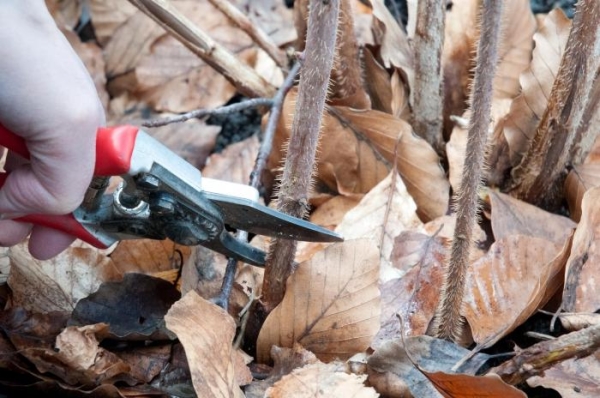
With the help of pruning, they regulate the height of the plant, on which the saturation of the branches with nutrients depends.Depending on the variety, the height varies between 1.2–1.7 m.
Control over the growth of bushes is needed for a delicious harvest. Raspberries grow at a fast pace and if you don’t follow this, then in a year a neat row will turn into abandoned thickets.
With a dense neighborhood, young berries do not receive the necessary sunlight, slowly ripen and, as a result, sour. The ideal distance between the bushes is 60–70 cm, and rows - 1.5 m.
This layer will help to effectively deal with weeds, preserve moisture in the soil, and improve the water-air regime.
Garter and buckle represent two stages of a single action. - prepare and save the bushes from frost and winter drafts. Their essence is to interconnect the stalks of bushes and bend them to the ground, which is the best heater.
How to care for raspberries after harvesting
Hardly had time to enjoy the harvest of this season, as soon as you need to think about the following. Caring for raspberries after picking berries in August implies:
- pruning shoots and dried branches;
- soil loosening;
- top dressing with fertilizers;
- tying bushes.
The first thing to do is to pick the last berries - cut branches where they grew. Anyway, next summer young shoots will actively produce.
For this manipulation, it is better to choose a pruner with long handles, thanks to which you can reach the depths of the bush. Cut branches are thrown out or burned in an iron container.
You need to cut not only old shoots, but also diseased branches. A properly trimmed plant should have 6–7 young shoots.
If necessary, you need thin out the bushes, giving a well-groomed raspberry look. This will not only add aesthetic beauty, but also allow the plant to breathe better.
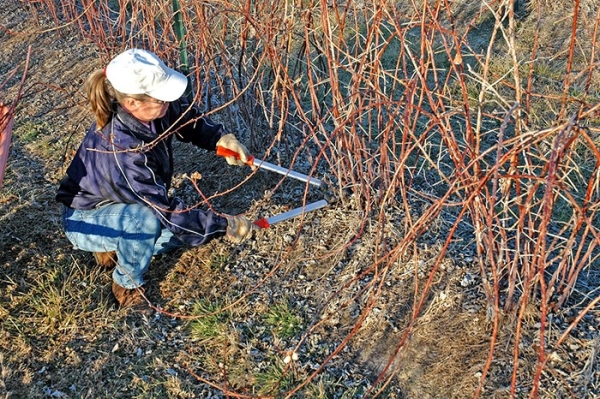
Now it’s time to loosen the soil easily. Raspberry root is shallow, so making a thorough digging with a shovel is prohibited.
The ideal option would be surface loosening with small forks. After this action, the roots will get more oxygen, weed growth will decrease.
Loosened earth is an excellent fertilizer base.. Suitable phosphorus or potassium, which is scattered around the circumference of the bushes. For each bush use 1 tbsp. l fertilizer.
To prevent the occurrence of fungal diseases not prevent spray raspberry solution with insecticidesFor example, 1% Bordeaux liquid.
Those who wish to fertilize raspberries with liquid organic matter or nitrogen should leave their thoughts until spring, in winter they will be of no use. Nitrogen fertilizers apply a maximum until mid-September.
Garter remains at the finish, which is that a strong wind and snow drifts do not break the branches of the bushes.
It is necessary to build a support, for example, it can be a lattice fence, and in several places tie each bush to it. Thanks to the garter the plants will gain additional strength.
Such simple actions will help the raspberry to winter, and in the summer to indulge with tasty berries.
Autumn processing scheme
Autumn processing raspberries not much different from the care after harvest. Basically, all raspberry varieties finish producing in the fall, after which the processing begins: pruning, thinning, loosening, fertilizing, tying.
If you ignore these actions, even remontant varieties will lose the ability to give birth twice.
You should not remove the leaves of raspberry, which fell under a bush, it is better to sprinkle them with sawdust. By spring, this layer will become humus.
You may be interested in our articles:
To the previously described care should be added:
- topping;
- treatment of plants from pests.
Chipping produce to form bushes and accelerate the ripening of annual shoots that contribute to yield.
Thanks to this agrotechnical reception, the growth of the uncircumcised branches is enhanced, the buds are awakened, contributing to the growth of side branches.
It is necessary to pinch only tall varieties of raspberries, not prone to branching, but low-growing plants do not need this technique.
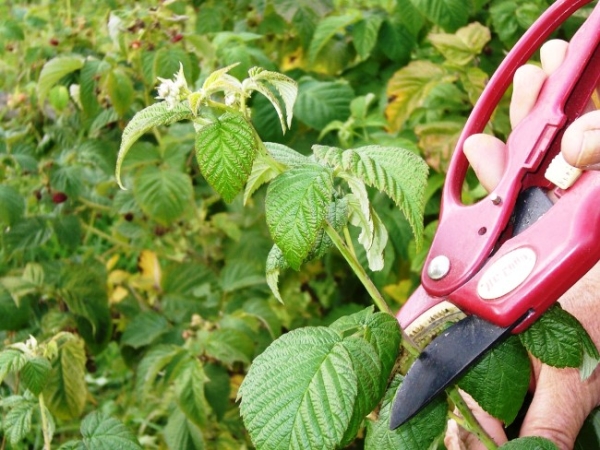
So that the nipping does not harm the raspberries, they make it from the second year after planting a healthy, strong seedling. For pinching, they connect two tops of young shoots with a length of 7–10 cm.
In addition to cleaning the territory, digging and thinning, care should be taken to eliminate dangerous insects or to prevent. If there are infected leaves and branches, they should be cut off and be sure to burn.
To combat diseases or pests use these tools:
- Fufanon - solution for spraying, prepared in proportion to 10 ml of insecticide per 10 liters of water. Consumption - 1-1,250 liters per bush.
- Actellic - ampoules, 1 ampoule is used for 2 liters of water. On 1 bush to use 1.5 liters of the finished solution.
- Intavir - pills. Before processing, dilute 1 tablet into a bucket of water.
- Iron / copper sulfate help win moss lichen. The solution is poured on the ground near the bushes.
A separate item is the shelter raspberry from the harsh winter.
How can you prepare the bushes for shelter
By wintering raspberry bushes include the following preparation measures:
- mulching;
- tying up;
- shelter;
- snow retention.
In mid-October, mulch covers an average of 15 cm.This will help the root system retain heat and the necessary moisture.
In addition, when it starts to decompose, it will perform the function of organic materials, contributing to the growth of the root system, and rich fruiting.
To tie up the branches of a plant you needso that they do not break under the weight of snow. Different materials and constructions, for example, ordinary wooden posts, are used as a support, and to draw a wire between them.
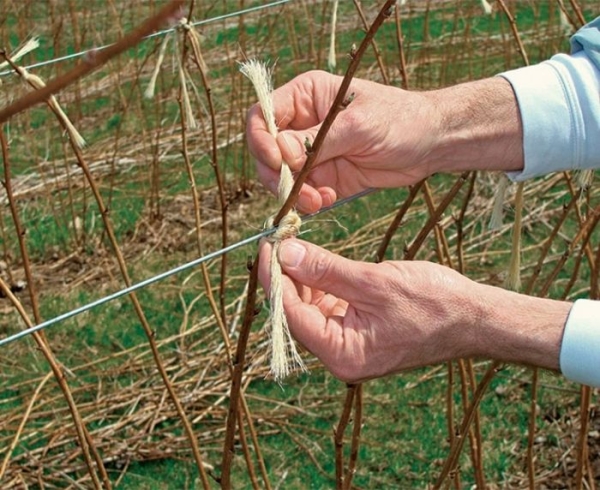
The bottom wire must withstand a distance of –18–21 cm from the ground. It is necessary to do this thing in the fall before the frost so that the stems are numb and can bend.
Tie up the bushes in several places, bending the branches of the arc, using a strong cord or nylon thread.
Raspberry shelter important for gardeners living in particularly cold harsh edges, with insufficient snow precipitation. This is done at the last moment after bending the plants.
To provide additional heat, you should pull a spandbond or lutarsil over the bushes, then press it down with something heavy along the edges so that it is not blown away by the wind.
Alternatively, you can build a protective structure of polycarbonate, which bends.
Snow retention is a measure taken to accumulate snow. in the edges, where its winter deficit. For raspberries, the snow level should not exceed 100 cm.
Melt snow water is of great importance for the land and plants directly, so it is important to delay the moment of its separation.
To do this is necessary in February, at a temperature of about 0 degrees, build heaps of snow and cover them with a shield or use different items for a “living” hedge.
How to bend down - the necessary stage of preparation for winter
It is advisable to bend down all varieties, even frost-resistant, because in reality many of them do not survive winters. Crouching is done so that the bushes are completely covered by snow and not frozen, and also to protect them from drafts.
The easiest waywhich is used in mid-October:
- Carefully trim the top of the branches and leaves.
- Slowly, in order not to damage the plant, roll the bushes into a heap with a thick rope.
- At the other end, tie the weight and put it on the ground.
The plant will immediately bow to the ground. If everything is correct, the bushes will be bowed in one direction by an arc.
As a second method You can offer to tie each other branches, and then tie them to the wire on the support.
Raspberries should not lie on the ground, the distance between it and the soil - an average of 20 cm.
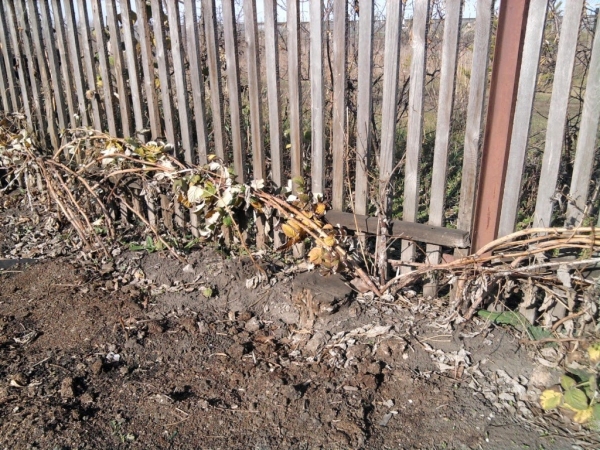
How to prune and prune in the fall
Pruning carried out in late autumn, before the onset of the first frost. There are different types of trimming, but the two most commonly used are:
- shortening;
- normal pruning.
Shortening means removing the tops of the plants., suitable for common varieties. With standard pruning, 60–70% of the stem is removed, and if this is the case with the remontant variety, it can be shortened almost to the ground.
The main thing is that the vegetative force of raspberry was high, and then it quickly grew. When pruning varieties of conventional and standard raspberry secateurs, two-year shoots are completely removed.
Caring for raspberries in the fall is not as time consuming and difficult as it may seem. Of course, it is necessary to work a little, but by the summer fatigue will be forgotten, and a rich harvest of ripe sweet berries will delight.
If you do not remove the protective cover, the soil will suffer from lack of oxygen, airing, and will also be susceptible to fungal infections and dampness.
